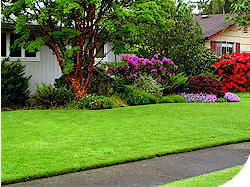Reseeding & Over Seeding..
.
Grass like every living thing on the earth has a life cycle. Even though most lawns are perennial in nature they get old and tired. Because of the mowing process the seeds never get to form or if they do, they probably get mowed off. So, the opportunity to thicken up the lawn is negated. That's where we have to step in and help nature via lightly reseeding. Reseeding should be done on an annual basis, primarily in the fall (September and early October).

Many home lawns, especially those 10 years old or older, were established with common type turf grasses which don't meet the needs of today's homeowner. These lawns tend to be more disease and insect prone, take more fertilizer and water, or they just have a plain old "worn out" look. Newer turf-grass varieties have been developed to withstand insects, disease, drought, shady conditions and heavy traffic better. The investment in over-seeding pays off by reducing the amount of fertilizer, water and pesticides required. Most importantly, however, is that a renovated lawn looks better. It stays greener and looks healthier! If a lawn has at least 50% or more healthy turf, it is usually worth saving by following good renovation practices. However, if the lawn has less than 50% healthy turf, complete renovation and replanting may be the best alternative. This involves killing out the old turf, weeds, etc., and reseeding the entire lawn.
Early fall is the best time to over-seed lawns. Soil and atmospheric temperatures are most favorable for optimum seed germination and growth. With adequate moisture, fertilizer and sunlight, the new seedlings will be well established before cooler fall weather sets in. Also, weed competition is less of a factor at this time, giving the grass seedlings a better environment to grow and develop.
